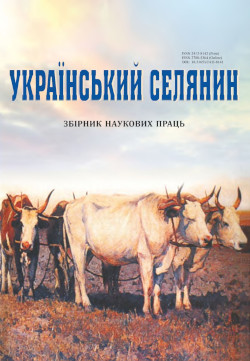Coverage of the Holodomor of 1932-1933 in Ukraine in the English-Speaking Media as an Antidote to the Soviet Disinformation Policy
Main Article Content
Abstract
The purpose of the article. The author of the article aims to investigate the methods used by the Soviet government, particularly through contemporary media, to suppress information about the Holodomor of 1932—1933
in Ukraine. Additionally, the article seeks to illuminate how English-language mass media countered the spread of Soviet disinformation regarding the Holodomor in Ukraine.
The scientific novelty. The previous issue of reflecting objective facts about the Holodomor of 1932—1933 in Ukraine in English-language media, as well as the mechanisms of Soviet propaganda to suppress information about the Holodomor, has been explored in the works of A. Kozytskyi, V. Gudz, A. Mikheiev, and other researchers. Most studies by these scholars focus either on describing the events or on Soviet disinformation policies in general. Our study focuses on specific methods through which English-language media countered Soviet disinformation, analyzing specific articles, reports, and testimonies of journalists, while also considering specific examples of disinformation spread in Soviet media.
Conclusions. Seeking to control information about the famine in Ukraine, the Soviet government prevented foreign journalists from freely accessing the affected areas to conceal the scale of the famine and prevent international outcry. Soviet media reacted to reports in foreign mass media by attempting to refute information about the famine in the USSR and portray it as an anti-Soviet smear campaign to discredit Western sources. Despite active disinformation efforts by the Soviet government,
truthful accounts of the Holodomor of 1932—1933 in Ukraine began appearing in the foreign press due to witnesses, journalists, diplomats, politicians, and public figures from Western countries. Newspapers such as «The Guardian», «The New York Times», «New York Herald Tribune», «Daily Telegraph», and others regularly reported on the unprecedented famine in Ukraine. Publications by G. Jones and M. Muggeridge sustained international interest in the Ukrainian situation and kept the issue of famine in the forefront of global public opinion, making it more difficult for the Soviet authorities to conceal the truth.
Article Details
References
Avstriiskaya pechat rasprostranyaet gnusnuyu antisoveskuyu klevetu. [The Austrian press is spreading vile anti-Soviet slander]. (1933). Tikhookeanskaya zvezda. [Pacific star], 160 [in Russian].
Harry, A. (2011). Soobshchenye spetsyalnoho korrespondenta «Yzvestyi» «Frantsuzskye hosty porazhenы uspekhamy stroytelstva v Sovetskoi Ukrayne». [Message from a special correspondent of Izvestia “French guests are amazed at the success of construction in Soviet Ukraine”]. Holod v SSSR 1929-1934. [Famine in the USSR 1929-1934]. [in Russian].
Gudz, V. (2014). Pochatkovyi etap doslidzhnia istorii Holodomoru v Ukraini. [The initial stage of research of the famine in Ukraine]. Naukovi zapysky Natsionalnoho universytetu “Ostrozka akademiia” [Scientific notes of the National University “Ostroh Academy”], 22, 234-246. [in Ukrainian].
Jones G. (1933) Famine grips Russia, millions dying. Idle on Rise, says Briton. New York Evening Post. Retrieved from https://www.garethjones.org/margaret_siriol_colley/Famine_gripsrussiahtm.htm [in English].
Kozytskyi, A. (2023). Velyka brekhnia. Metody, naratyvy ta dynamika zaperechennia holodomoru. [The Big Lie: Methods, Narratives, and Dynamics of Holodomor Denial]. Kharkiv. [in Ukrainian].
Mikheiev, A. (2022). Reaction of the English-speaking world on the Holodomor 1932-1933 in Soviet Ukraine. European philosophical and historical discourse, 8, 26-32. [in English].
Moskvin, L. (1933). O lzhetsakh y provokatorakh yz laheria burzhuazyy. [About liars and provocateurs from the bourgeois camp.]. Yzvestyia. [in Russian].
Mowrer, E. (1933). Russian Famine Now as Great as Starvation of 1921, Says Secretary of Lloyd George. Retrieved from https://www.garethjones.org/soviet_articles/edgar_mowrer.htm [in English].
Muggeridge, M. (1933). Deliberate famine in Russia. Retrieved from https://www.theguardian.com/news/1933/mar/25/mainsection.fromthearchive. [in English].
Muggeridge, M. (1933). Exposing Stalin’s famine in Ukraine – archive, 1933. Retrieved from https://www.theguardian.com/world/2022/mar/02/exposing-stalin-famine-in-ukraine-muggeridge-1933 [in English].

